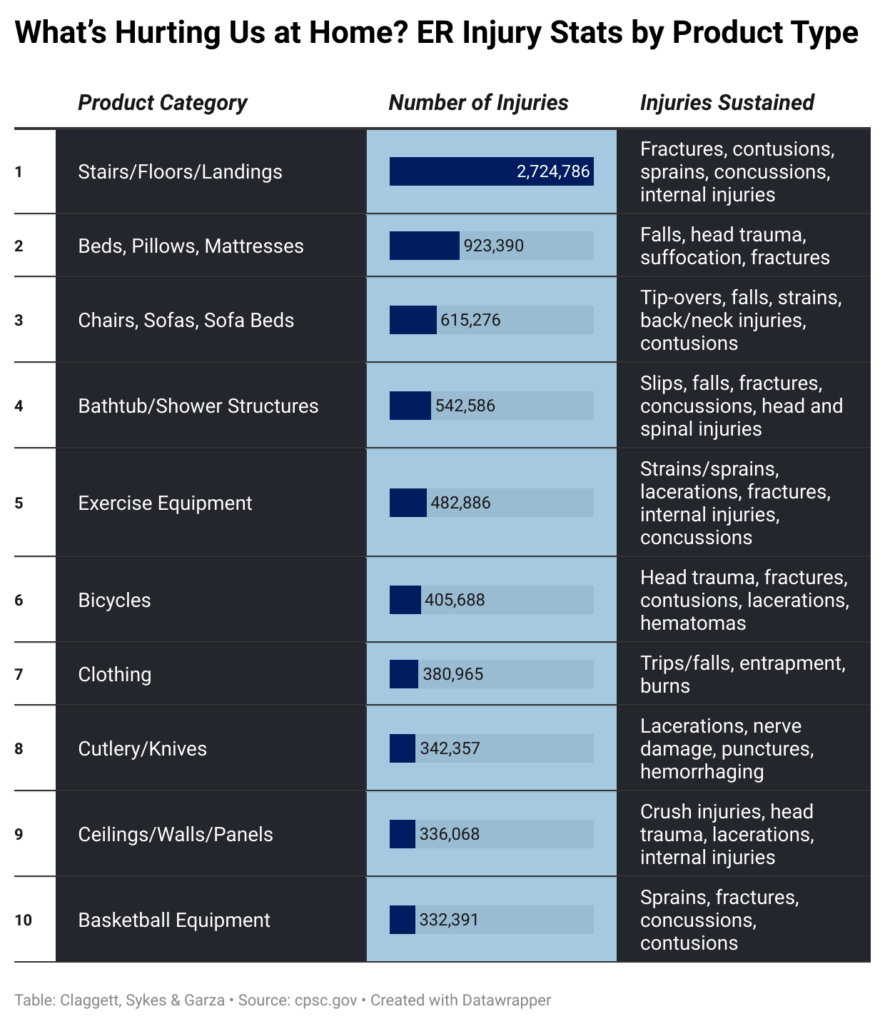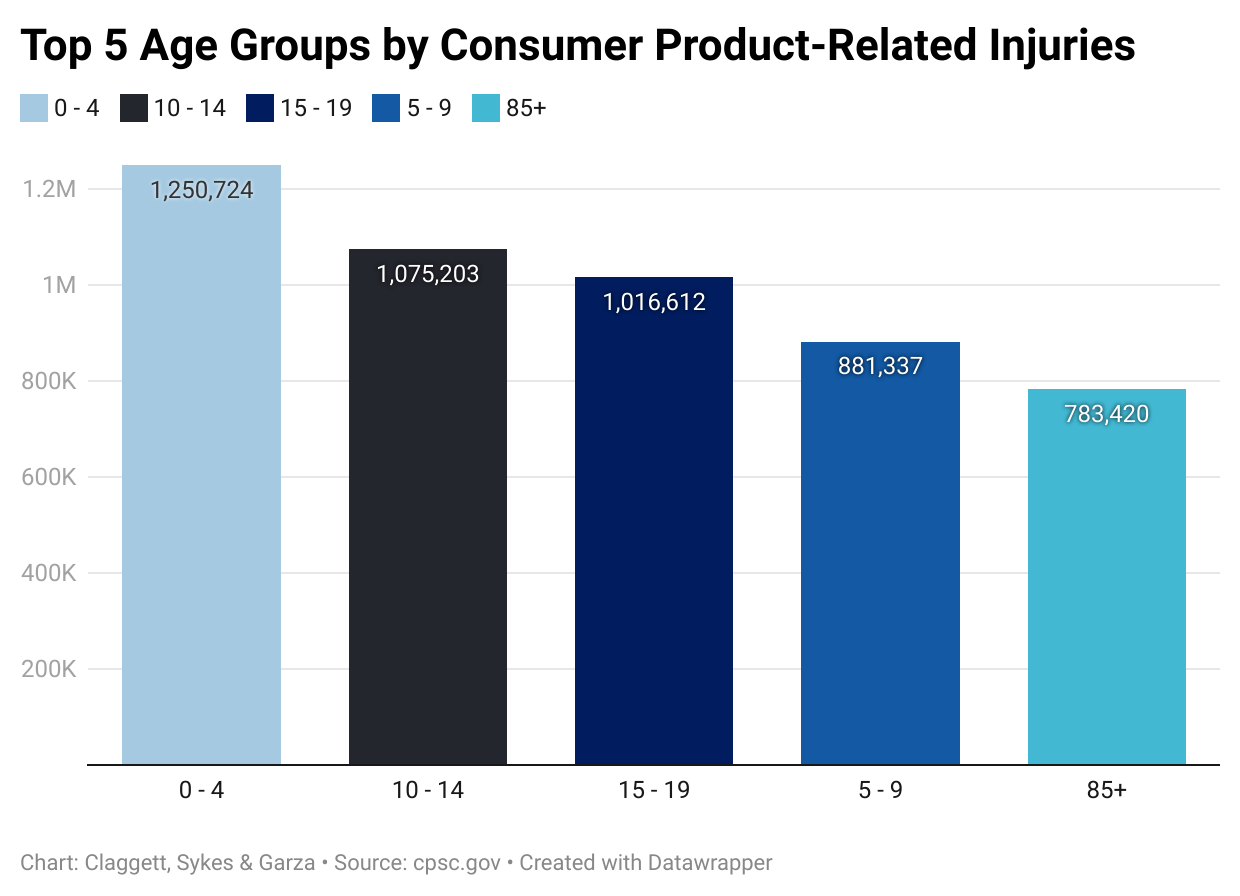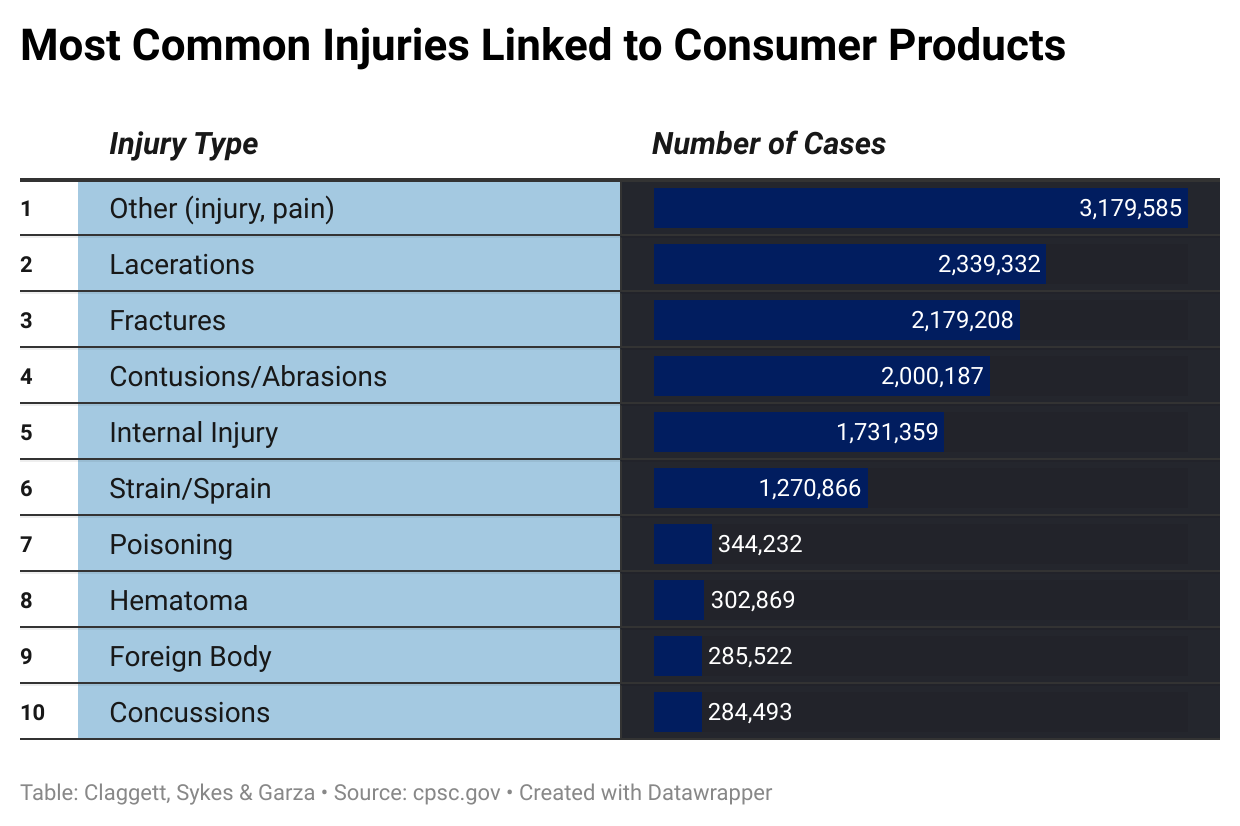We Rightly Consider Our Homes Our Havens, A Place Where We Can Switch Off And Unwind – But Dangers Lurk In Every Room
Our homes are full of the things we use every day, some of which are indispensable parts of our functioning lives. But many are not just our useful allies: some can be extremely dangerous, and even cause serious injury. 1 in 26 people in the U.S. are injured at home every year.
This study will consider the main causes of injury, who is most likely to be injured in the home, why the injuries occur, and some potential ways to keep injury numbers down.
The Most Dangerous Things In Your Home
According to National Safety Council data, in 2023, 12.7 million Americans (4% of the US population) were treated in emergency rooms for injuries sustained while using everyday items or fixtures at home.
Stairs, floors, and landings are the biggest issue in the home, injuring 2.724 million people every year. Beds, pillows, and mattresses (923,390 injuries), chairs, sofas, and sofa beds (615,276), bath and shower fixtures (542,586) and exercise equipment (482,886) make up the top five issues.
The full top ten list of household items that cause the most injuries across the U.S. is as follows.

The most common kinds of injuries sustained during everyday life are lacerations, fractures, contusions/abrasions, internal injuries, strains and sprains, poisoning, hematomas, and concussions. Other types of injuries caused in or around the home include burns, punctures, nerve damage, hemorrhaging, and crushing injuries.
So many of the seemingly harmless products we use every single day—often without thinking—pose a risk of injury. Common household items like kitchen knives, microwaves, and stovetops are responsible for thousands of emergency room visits each year due to burns, cuts, or scalds.
Bathroom products such as curling irons, space heaters, and slippery mats also frequently cause falls and minor burns. Even harmless items like furniture can represent danger, with injuries caused by tipping furniture sending thousands of people to the hospital every year – especially young children.
Other everyday hazards include cleaning products (which can cause chemical burns or respiratory irritation) and electronic items with frayed cords or overheating batteries. Such daily-use tools are essential. Yet, without due caution, all represent a serious injury risk.

The Main Victims Of Injuries From Everyday Items and Fixtures
Study data suggests that, during 2023, the 0-4 age group suffered the most injuries (over 1.25 million) of any age group. The over 85s also rank highly, in the top 5 age ranges suffering household injuries – 783,420, despite representing a significantly smaller proportion of the population.
This clearly shows that toddlers and seniors alike are particularly vulnerable, due to physical fragility, limited mobility, and a shared high fall risk.
The 10-14 and 15-19 age groups each suffered 1 million injuries. These years consist of a high level of activity (including additional sports participation) and increased independence—which consistently present myriad opportunities for injury.
Combined, the 0-4 and 5-9 age groups account for more than 2.1 million injuries. This suggests a need for stronger childproofing of everyday items, better general product safety, and more focus on encouraging better parental supervision.
From the age of 65 until 85, home injuries steadily increase. The data shows us a growing number of fall-related injuries, largely due to reduced coordination and frailty, especially in homes not designed for senior citizens.
Overall, injury risk is a varying matter for all age groups, distributed across an entire lifespan. But it’s certainly true that toddlers, teens, and older people visit the emergency room most of all when it comes to everyday products.
0-4 Years Old
For this age range, according to study data, the products that cause the most injuries are unpowered toy scooters, balls, and toy vehicles. Beyond the realm of toys, toddlers, and infants also frequently suffer injury (sometimes serious injury) from furniture tip-overs, with unanchored furniture like dressers and TVs easily felled if climbed.
Falls from beds, stairs, and playground equipment are also regular occurrences among the under-5s. Other prevalent issues for this age range include burns from hot liquids and after touching hot surfaces like stoves and choking after swallowing small objects or food items.
5-9 Years Old
The biggest cause of injuries for the 5-9s is toys, followed by sports equipment, bicycles, and scooters.
10-14 Years Old
As with the 5-9s, sports equipment causes a significant number of injuries among 10-14s, with bicycles, scooters, and kitchen appliances high up on the injury-threat list. Fractures, sprains, lacerations, and concussions are common injury types.
15-19 Years Old
For the 15-19s, motorized vehicles such as UTVs, e-bikes, hoverboards, sports equipment, and household tools cause most injuries, with strains, sprains, and concussions common afflictions for this age group.
20-64 Years Old
Kitchen appliances, ladders, furniture, exercise equipment, and power tools are the main causes of injuries for adults between the ages of 20 and 64. The most common types of injuries are cuts, lacerations, fractures, sprains, strains, and burns.
65-85 Years Old
The leading causes of injuries for this age bracket are trips on stairs, rugs, and due to flooring; heaters, stoves, and personal mobility aids are also big issues. The most common injuries include falls, fractures, concussions, and burns.

Why Summer Is Peak Injury Season
Summer is the peak season for consumer product-related injuries due to a combination of increased outdoor activity, wider use of seasonal products, and various holiday-related risks.
According to the U.S. Consumer Product Safety Commission’s National Electronic Injury Surveillance System (NEISS), summer months see a significant uptick in injuries associated with consumer products.
This surge in injuries is attributed to factors like more time spent outdoors – which leads to increased exposure to potential hazards like grills, lawn equipment, and recreational gear. Additionally, products that were often redundant during colder months—bicycles, trampolines, and swimming pools—are once again popular, often without proper maintenance checks, which increases the risk of an accident.
Children are particularly vulnerable during this period, with nearly a million children visiting emergency rooms between June and August due to injuries related to summertime-centric products.
The Fourth of July holiday also contributes to the spike, with fireworks-related injuries comprising a significant portion of emergency room visits during the first week of July.
The combination of increased physical activity, higher temperatures (and subsequent increased levels of fatigue), and the use of potentially hazardous products means heightened safety awareness is key during the summer months.
Why Homes Are More Dangerous Places for Women
The range of product-related injuries differs for men and women. It’s not just a matter of the frequency of injuries, but also the types of products causing harm. According to national injury surveillance data, women suffer more injuries from household and consumer products, especially in categories like:
- Furniture (tip-overs)
- Kitchen appliances (lacerations, burns)
- Slip, trip, and fall-related items (rugs, wet floors, step ladders)
- Personal care products (hair tools, cosmetics)
There are good reasons for this disparity. Women are more likely to be injured by consumer products in the home due to a combination of societal expectations, product design biases, and longer exposure to certain environments.
Traditionally, as well as statistically, women spend more time in the home and take on a greater share of domestic and caregiving responsibilities. This naturally increases female interaction with potentially hazardous products like kitchen appliances, cleaning agents, personal care items, and children’s toys.
Many of these products were not designed with women’s bodies in mind, leading to poor ergonomics, male-centric dimensions, or instructions that don’t cover common scenarios that women regularly face.
Additionally, women tend to use a wider range of chemical-based products than men and may be more sensitive to long-term exposure to substances like endocrine disruptors or allergens. Their role as caregivers also puts them in frequent contact with child-related items—products that often carry higher injury or recall rates.
And, women are more likely to seek medical attention after using products or report product-related injuries, which may also contribute to higher documented injury rates. Ultimately, it’s not about women being more accident-prone—it’s about systems, products, and environments that were not designed with them in mind.
Product Safety Has a Gender Bias Problem
According to U.S. Consumer Product Safety Commission (CPSC) data, women suffer nearly 60% of all injuries caused by consumer products. This includes injuries from home furnishings, kitchen appliances, and personal care devices—products often marketed heavily toward women but rarely tested on female users.
The root of the problem begins before products reach the home or supermarket shelves. As an example, a study on personal protective equipment found that women’s palms are on average 0.4 inches smaller than men’s. Yet, most tools and gloves are manufactured to fit male dimensions, leading to improper grip and higher injury risk.
Medication and health devices have historically been tested on male subjects, meaning women are significantly more vulnerable than men to side effects and misdiagnoses.
This imbalance isn’t a design oversight—it’s a baked-in data problem. To correct this in the home would require incorporating gender-specific data into every stage of home product development, testing, and regulations.
In terms of male statistics, they’re more likely to be injured by power tools and machinery (cuts, lacerations, and shocks), sports and recreational equipment (sprains, concussions, and strains), vehicles, and electronics (mechanical failures, improper use).
These variations often reflect differing usage patterns, exposure levels, and risk behaviors. Overall, the data underscores the importance of and need for gender-informed product design, safety education, and targeted injury prevention efforts.
The Reasons Products Cause Injuries
While design flaws and manufacturing defects are key causes of consumer product injuries, they’re not the only reasons. One of the most common contributing factors to injuries from using consumer products is a failure to use something properly or poor handling.
Whether that’s using gym equipment without protective gear or failing to properly observe power tool safety advice, consumer error can turn an everyday item into a potentially dangerous weapon.
Another major issue is a lack of clear warnings or instructions on some products. If a product doesn’t clearly explain how it should be safely used, dangerous consequences are often inevitable, with burns, cuts, and even worse often the result, especially when it comes to items like grooming devices, appliances, and tools.
Study data directly links inadequate labeling with a spike in injuries related to personal care products, particularly when instructions are badly written.
Counterfeit products also represent a growing risk, especially those sold online, and the increasing prevalence of online shopping will exacerbate the problem. Cheap imitation chargers, untested toys, or cheaply made electronics may not adhere to U.S. safety standards, leading to fire risk, toxic exposure, or electric shock.
Faulty packaging worsens the problem. Items such as poorly sealed medicine bottles or sharp-edged food containers can lead to accidental poisoning or cuts, especially in households with children. Even packaging that looks secure may not be child-resistant, presenting a serious hazard.
With technology advancing at rapid speed, safety regulations, design reviews, and user education all need to recalibrate to keep up—when they don’t, it creates a dangerous imbalance that can lead to more injuries.
Many new tech products, from wearable devices to e-bikes and AI-powered tools, hit the market before comprehensive safety testing or updated standards are ready. The often unprecedented nature of some innovative products means risks may not have been spotted, with existing safety protocols not necessarily applicable.
Companies racing to out-maneuver the competition may prioritize speed over safety, leaving consumers and workers to use complex tech without proper training. Smaller businesses may also lack the resources to put in place the requisite cutting-edge safety upgrades, making them more vulnerable to risk.
Even when safety tools are available, concerns over data privacy can lead to delays around their being put to use. Ultimately, the thrill of the new can trump due diligence—until injuries force a rethink. Keeping up with the constantly evolving world of innovative tech products means updating standards in real-time, promoting up-to-date user education, and making sure safety innovation can match the technology.
Some contemporary products unfortunately get the better of their users, with the following 5 popular brands injuring and even killing American consumers.
- Future Motion One-Wheeled Scooters
Four deaths have been reported following the use of these scooters, along with multiple serious afflictions, including TBI, and bone fractures.
- Fitbit
Over 115 burn injury incidents have been reported by Fitbit users, including second and third-degree burns.
- Apple Watch
There have been multiple reports of burn injuries from Apple Watch users, including first- and second-degree burns, plus several cases of dermatitis.
- Rad Power E-Bike
Over 137 crash incidents have been reported following the use of Rad’s e-bike, with associated broken bone injuries.
- Conair Blow Dryers
These dryers have caused both burns and fires across multiple users.
A Plethora Of Product Recalls
Product recalls in the U.S. climbed 10.6% in 2023, hitting a seven-year high, according to a Sedgwick Recall Index report. That year saw 3,301 separate recall events across five major consumer sectors, marking a continuation of rising recall trends.
While the total number of affected units was lower than in 2022 (759.36 million, less than the one billion it had been two years earlier) the scale remains significant.
The drop merely represents a nearly 49% decrease in volume; the steady rise in the number of recall events points to increased regulatory pressure and the need for businesses to retain focus on proactive product safety measures.
Here’s a list of ten recalled items, plus the associated hazards that led to recalls.

Potential Steps to Try And Stem The Flow Of Alarming Trends
The magnitude of injuries caused by everyday consumer products and fixtures is not just alarming—it’s a nationwide safety concern that demands urgent attention. 12.7 million Americans treated in emergency rooms in 2023 for product-related injuries is far too many.
This is not just a matter of freak accidents—it’s a growing, systemic problem that demands urgent action. From toddlers injured by toy scooters and furniture tip-overs to seniors felled by rugs and stairs, the full spectrum of at-risk ages is encompassed.
Study data regarding injury trends shows that the youngest and oldest (and most vulnerable) Americans bear a disproportionate burden.
Data also emphasizes gender disparities, with women more frequently injured than men in the home, particularly by furniture, kitchen appliances, and personal care products; men in turn are more likely to be hurt by power tools, sports equipment, and electronic devices. These disparities are not just about usage patterns.
They reflect deeper issues around how safety standards, product design, and labeling often fail to account for very different users or real-world behavior.
Ultimately, a toxic mix of poorly designed products, featuring often unclear safety instructions or inadequate labeling (products which are then often misused), shonky, untested goods, and even faulty packaging all contribute to a shocking number of injuries.
While recalls are on the rise (3,300 in 2023 alone), they’re reactive by nature and usually mean things have already gone wrong, with many people potentially already injured.
It’s surely far better to focus far more assiduously on prevention. By investing in human-centered product design, tougher safety regulations, clearer consumer education, and equitable safety standards that account for all users, we can begin to provide the safer, better products consumers deserve.
At Claggett, Sykes & Garza, we’re the injury experts you need. If you’ve experienced a problem with a product at home, get in touch with us today for help.